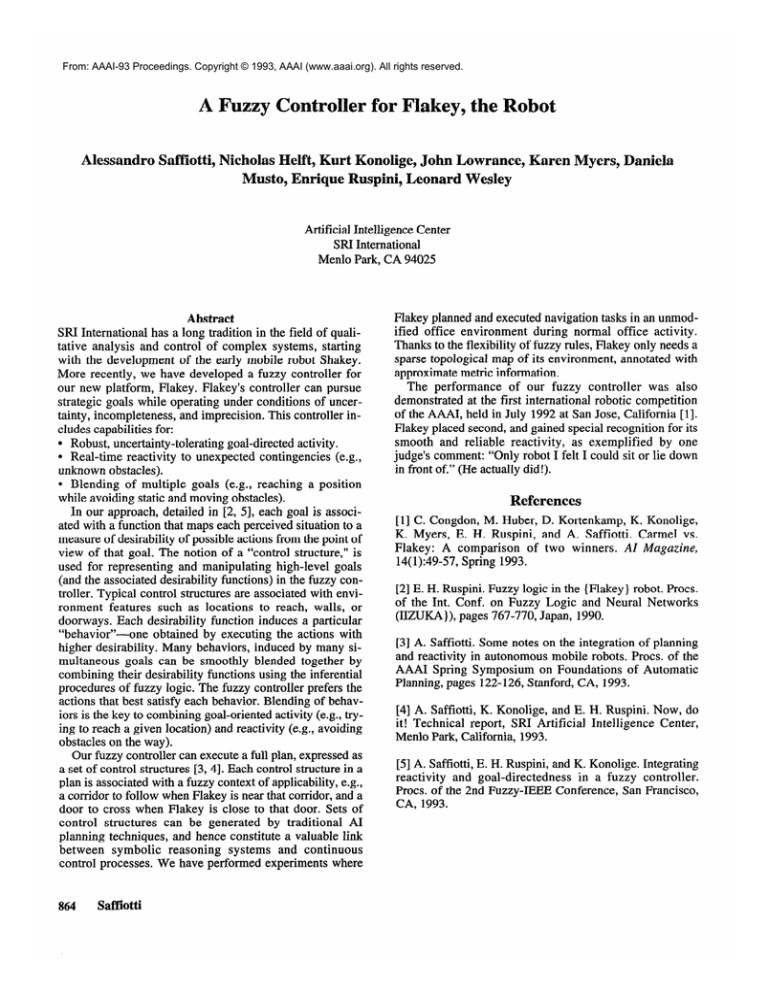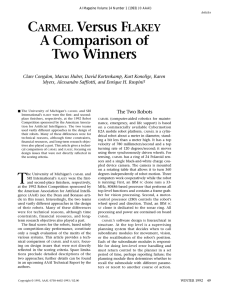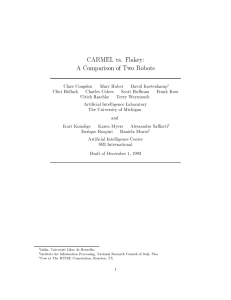
From: AAAI-93 Proceedings. Copyright © 1993, AAAI (www.aaai.org). All rights reserved.
A Fuzzy Co
Alessaudro
er for Fhkey,
the Robot
Saffbtti, Niclmlas
elft, Kurt Konolige, John Lowrance, Karen Myers, Daniela
Musto, Eurique Ruspini, Leonard Wesley
Artificial Intelligence Center
SRI International
Menlo Park, CA 94025
Abstract
SRI International has a long tradition in the field of qualitative analysis and control of complex systems, starting
with the development
of the early mobile robot Shakey.
More recently, we have developed a fuzzy controller for
our new platform, Flakey. Flakey’s controller can pursue
strategic goals while operating under conditions of uncertainty, incompleteness,
and imprecision. This controller includes capabilities for:
Robust, uncertainty-tolerating
goal-directed activity.
0 Real-time reactivity to unexpected contingencies
(e.g.,
unknown obstacles).
* Blending of multiple goals (e.g., reaching a position
while avoiding static and moving obstacles).
In our approach, detailed in [2, 51, each goal is associated with a function that maps each perceived situation to a
measure of desirability of possible actions from the point of
view of that goal. The notion of a “control structure,” is
used for representing
and manipulating
high-level goals
(and the associated desirability functions) in the fuzzy controller. Typical control structures are associated with environment features such as locations to reach, walls, or
doorways. Each desirability function induces a particular
“behavior” -one
obtained by executing the actions with
higher desirability. Many behaviors, induced by many simultaneous
goals can be smoothly blended together by
combining their desirability functions using the inferential
procedures of fuzzy logic. The fuzzy controller prefers the
actions that best satisfy each behavior. Blending of behaviors is the key to combining goal-oriented activity (e.g., trying to reach a given location) and reactivity (e.g., avoiding
obstacles on the way).
Our fuzzy controller can execute a full plan, expressed as
a set of control structures [3,4]. Each control structure in a
plan is associated with a fuzzy context of applicability, e.g.,
a corridor to follow when Flakey is near that corridor, and a
door to cross when Flakey is close to that door. Sets of
control structures
can be generated
by traditional
AI
planning techniques, and hence constitute a valuable link
between
symbolic
reasoning
systems and continuous
control processes. We have performed experiments where
l
864
Safflotti
Flakey planned and executed navigation tasks in an unmodified office environment
during normal office activity.
Thanks to the flexibility of fuzzy rules, Flakey only needs a
sparse topological map of its environment,
annotated with
approximate metric information.
The performance
of our fuzzy controller
was also
demonstrated at the first international robotic competition
of the AAAI, held in July 1992 at San Jose, California [ 11.
Flakey placed second, and gained special recognition for its
smooth and reliable reactivity,
as exemplified
by one
judge’s comment: “Only robot I felt I could sit or lie down
in front of.” (He actually did!).
References
[l] C. Congdon, M. Huber, D. Kortenkamp, K. Konolige,
K. Myers, E. H. Ruspini, and A. Saffiotti. Carmel vs.
Flakey: A comparison
of two winners. AZ Magazine,
14( 1):49-57, Spring 1993.
[2] E. H. Ruspini. Fuzzy logic in the {Flakey } robot. Procs.
of the Int. Conf. on Fuzzy Logic and Neural Networks
(IIZUKA}), pages 767-770, Japan, 1990.
[3] A. Saffiotti. Some notes on the integration of planning
and reactivity in autonomous mobile robots. Procs. of the
AAAI Spring Symposium on Foundations
of Automatic
Planning, pages 122- 126, Stanford, CA, 1993.
[4] A. Saffiotti, K. Konolige, and E. H. Ruspini.
it! Technical report, SRI Artificial Intelligence
Menlo Park, California, 1993.
Now, do
Center,
[5] A. Saffiotti, E. H. Ruspini, and K. Konolige. Integrating
reactivity
and goal-directedness
in a fuzzy controller.
Procs. of the 2nd Fuzzy-IEEE Conference, San Francisco,
CA, 1993.





